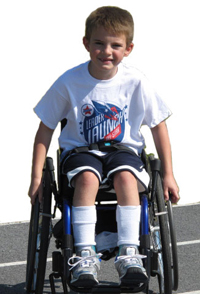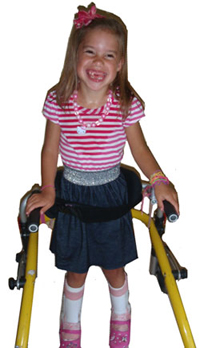Tracking Methods for Cerebral Palsy

CDC has been studying cerebral palsy (CP) since the early 1980s. By tracking the number of children diagnosed with CP over time, we can find out if the number is rising, dropping, or staying the same. We can compare the number of children with CP in different groups of people and in different areas of the country. This information can help us look for causes and risk factors of cerebral palsy, evaluate the effectiveness of prevention efforts, raise awareness of the signs and symptoms, and help families and communities plan for services. Determining whether these changes affect the rates of CP over time requires ongoing, systematic population-based tracking.
Determining How Many People Have Cerebral Palsy—Tracking
CDC tracks the number and characteristics of children with CP living in several diverse communities across the United States (US). Communities can use CDC’s information on the number and characteristics of children with CP, such as subtype, walking ability, and co-occurring conditions, to plan for services, guide policy, and promote full participation in community and family life. Information about the co-occurrence of CP and other conditions, such as autism spectrum disorder, can also help direct research into shared risk factors and causes.
The following are activities that CDC conducts or funds in order to learn more about the number and characteristics of children with CP:
Metropolitan Atlanta Developmental Disabilities Surveillance Program
MADDSP was established in 1991 to identify children with four disabilities (CP, hearing loss, intellectual disability, and vision impairment). A fifth disability, autism spectrum disorder, was added to the program in 1996. MADDSP conducts ongoing tracking for developmental disabilities among 8-year-old children living in the metropolitan Atlanta area. This program has contributed a wealth of information on the characteristics, risk factors, costs, and implications of developmental disabilities, including CP.
Autism and Developmental Disabilities Monitoring Network
The ADDM Network is a group of programs funded by CDC to estimate the number of children with autism spectrum disorder and other developmental disabilities living in different areas of the US. The ADDM Network sites all collect data using the same methods, which are modeled after CDC’s Metropolitan Atlanta Developmental Disabilities Surveillance Program (MADDSP).
Currently, there are four sites tracking CP in areas of Alabama, Georgia, Missouri, and Wisconsin as part of the ADDM CP Network. The ADDM CP Network sites do not make up a nationally representative sample, but in 2008 their combined areas represented approximately 3% of 8-year-olds in the US. The ADDM CP Network’s goals are to:
- Obtain as complete a count as possible of the number of children with CP in each ADDM Network site
- Study whether CP is more common in some groups of children than among others and whether rates are changing over time
- Improve the consistency of identification of people with CP
- Provide information on the characteristics of children with CP, including functional abilities and co-occurring conditions, such as epilepsy
CDC estimates that about 1 in every 345 children in the US has been identified with CP. This data comes from the ADDM CP Network, which estimated the number of 8-year-old children with CP living in four communities throughout the United States in 2010.
Read the Community Report on the 2008 ADDM CP Network findings [PDF – 13 MB]
Read about the work taking place at each ADDM CP Network site by clicking one of the following links:
- Alabama [629 KB, 2 Pages, 508]
- Georgia [660 KB, 2 Pages, 508]
- Missouri [661 KB, 2 Pages, 508]
- Wisconsin [575 KB, 2 Pages, 508]
Learn more about the ADDM Network
Metropolitan Atlanta Developmental Disabilities Study (MADDS)
CDC studied how many children in metropolitan Atlanta had CP in the mid-1980s. This project was done as part of the Metropolitan Atlanta Developmental Disabilities Study (MADDS), which studied how common certain disabilities were in 10-year-old children. This study served as the basis for the creation of Metropolitan Atlanta Developmental Disabilities Surveillance Program (MADDSP).
One of the key findings of this study was that 16% of children acquired CP more than 28 days after birth. The acquired CP cases were due to: [Read article]
- Infections, such as meningitis or encephalitis
- Head trauma, for example, from a motor vehicle accident or fall
- Cerebrovascular accidents, that is, bleeding or a blood clot in the brain
- Anoxia or lack of oxygen to the brain
- Low blood sugar
Findings from this program were published in the following article:
A multiple-source method for monitoring developmental disabilities in children [PDF – 1.71 MB]

National Surveys
CDC conducts the National Health Interview Survey (NHIS) that provides data on health conditions in U.S. children and adults. The following recent articles published findings about trends in developmental disabilities and estimates of health-related limitations, needs, and service use among US children with CP:
Prevalence and Trends of Developmental Disabilities among Children in the United States: 2009–2017
Trends in the Prevalence of Developmental Disabilities in US Children, 1997-2008. [PDF – 252 KB]
Understanding Risk Factors—Research
CDC supports public health research, including studying potential causes of CP and other developmental disabilities. Both public health tracking and research efforts provide information necessary to direct prevention efforts. Here are some of the research programs that CDC has been or is involved in:
The Metropolitan Atlanta Developmental Disabilities (MADDS) Follow-up Study of Young Adults
In the mid-1980s, CDC conducted the Metropolitan Atlanta Developmental Disabilities Study (MADDS), a study of developmental disabilities (including CP) in 10-year-old children living in metropolitan Atlanta. The Follow-Up Study of Children with Developmental Disabilities contacted many of the original study participants years later, when they were young adults. They were asked questions about various subjects, such as their health, living arrangements, socialization, employment, and quality of life to assess their current functioning and transition into adulthood.
Findings from this study were published in the following articles:
Transition Issues Among Young Adults with Developmental Disabilities
Healthy Lifestyle and Behaviors Among Young Adults with Developmental Disabilities
Functioning and Young Adults with Developmental Disabilities
Leisure Activities and Young Adults with Developmental Disabilities
The CDC-Denmark Program (Project Completed)
Through the CDC-Denmark program, CDC supported studies of CP using the Danish National Cerebral Palsy Register to examine factors that might make it more likely a child will develop CP. Factors that were examined include multiple births, preterm birth, assisted reproductive techniques, and asphyxia or lack of oxygen before or during birth.
Findings from this program were published in the following articles:
CP in Children Born After Assisted Conception
CP Among Children Born After in Vitro Fertilization
Infant Development Study (IDS)
In the early 1990s, CDC scientists looked at very low birth weight infants born in Georgia from 1986 to 1988, to examine the effects of treatment with prenatal magnesium sulfate (given either for pre-eclampsia or preterm labor) on the risk for CP in low birth weight children. The results showed that fewer children whose mothers were given magnesium sulfate were later diagnosed with cerebral palsy, compared to children whose mothers were not given the treatment.
Numerous large clinical studies have subsequently evaluated the protective effects of magnesium sulfate.(1) The Committee on Obstetric Practice and the Society for Maternal-Fetal Medicine state that the available evidence suggests that magnesium sulfate given before anticipated early preterm birth reduces the risk of cerebral palsy in surviving infants.(2)
References
1. Doyle LW, Crowther CA, Middleton P, Marret S, Rouse D. Magnesium sulphate for women at risk of preterm birth for neuroprotection of the fetus. Cochrane Database of Systematic Reviews 2009, Issue 1. Art. No.: CD004661. DOI: 10.1002/14651858.CD004661.pub3.
2. Magnesium sulfate before anticipated preterm birth for neuroprotection. Committee Opinion No. 455. American College of Obstetricians and Gynecologists. Obstet Gynecol 2010;115:669–71.